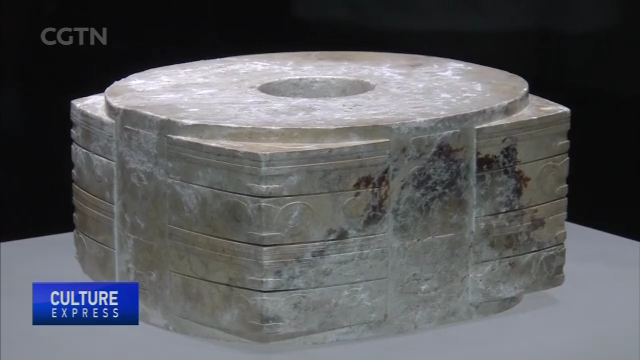
19:26, 19-Jul-2019
Liangzhu & Ancient China: Palace Museum showcases Liangzhu jade culture
Updated
19:44, 19-Jul-2019

People's fascination with jade, as far as we know, goes back more than 8000 years ago. It's now also the subject of an exhibition, called "Liangzhu and Ancient China", at the Palace Museum in Beijing. The exhibition includes 255 pieces of jade artifacts from 17 museums and institutes across China. Our reporter Qi Jie discovers with us the rich jade culture of the Liangzhu period, the height Chinese jade culture.
QI JIE BEIJING "Chinese ancient jade culture was usually associated with rituals, beliefs and decorations. But the modern world offers us few references when it comes to appreciating jade art. Here are some simple elements that can help you enjoy the beauty and understand the function of a jade artifact."
Take this huge piece as an example. Known as the KING of jade, representing the power of the King, this is Jade cong or Yucong in Chinese. Round on top and square at the bottom, the particular shape represents heaven and earth since ancient Chinese believed heaven was round and the earth square. The low relief carving of a human face is the symbol of god. The piece weighs six and a half kilograms, the largest ever found from the Liangzhu era. The larger the size and the more beautiful the craftsmanship, the higher symbolic power it has.
GAO MENGHE, CHIEF CURATOR 'LIANGZHU & ANCIENT CHINA' EXHIBIT "Chinese people are fond of jade. From making jade artifacts to jade culture, jade has become a spiritual symbol of the Chinese. Overseas friends may know jade more from the perspective of materials or craftsmanship, but Chinese consider jade as morality, integrity and dignity. Whether it is the Chinese way of thinking or the Chinese way of life, you can always use jade to interpret it."
And this axe-shaped piece is Jade yue or Yuyue in Chinese. Although it is only 9-millimeters thick, it is a symbol of the supreme military power of the Liangzhu Kingdom. The message delivered in the Jade cong and yue indicates that the supreme ruler of Liangzhu was no longer a clan or tribe leader, but the hero defeating enemies. He was the king governing the state and giving people peace and security, as well as connecting heaven and earth as the incarnation of god.
GAO MENGHE, CHIEF CURATOR 'LIANGZHU & ANCIENT CHINA' EXHIBIT "Chinese people used jade in three different stages. At the very beginning, people worshipped jade. Then, people used jade to show their social status or identity. And after the Han and Tang Dynasties, jade was present in ordinary households. So China's history of producing jade artifacts goes back as far as 8,000 years ago."
Here comes the queen of jade, Jade bi or Yubi in Chinese. The jade artifacts owned by female royalty included bracelets, groups of plaques, as well as round cards used for fun. The women were also buried with jade tools for weaving, which indicated the female identity.
The Chinese traditions of valuing and respecting jade are part of Chinese civilization. Highlighted by the Liangzhu era, it is expected that Chinese jade culture will continue to shine for generations. QIJIE, CGTN, BEIJING.
SITEMAP
Copyright © 2018 CGTN. Beijing ICP prepared NO.16065310-3
Copyright © 2018 CGTN. Beijing ICP prepared NO.16065310-3